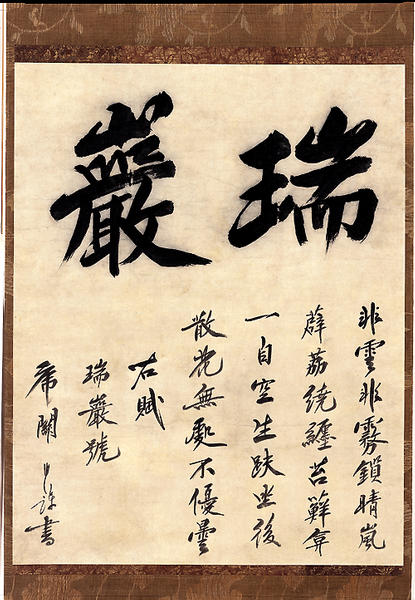虎関師錬書 瑞巖道号并号頌
- 鎌倉時代後期
- 14c
- 紙本墨書
- H-74.1 W-57.8
鎌倉時代後期 14世紀
紙本墨書
縦:74.1cm 横:57.8cm
東福寺十五世の虎関師錬(1278~1346)が,後に同寺三十四世となる瑞巌曇現に与えた道号ならびに号頌である。当時は道号,号頌をそれぞれ別紙に認めて授与するのが一般的な風潮であって,所掲の瑞巌号のごとく,一紙の上下に道号・号頌を分けて認める形式は,室町時代以降顕著となるものである。本書は同一紙に道号・号頌を認めた最も早い時期のものとして貴重であろう。
号頌に移ろう。
「雲かと思えば雲にもあらず,霧かと思えば霧にもあらず,晴れた日に蒸発する山気が一面に立ちこめている。その晴嵐の気に包まれた山中の大巌石には,つたかずらがまつわり,すっかり蘚苔におおわれている。
釈尊十大弟子の一人で解空第一と称された須菩提(空生)が,巌上で結跏趺坐してより後,周囲一帯に散花された花びらは,すべて優曇華ならざるはなかった。優曇華は3000年に一度花開く珍しい植物で,その花が咲くときは金輪明王が出現すると言われている。」
虎関は瑞巌趺坐の周囲にも,優曇華の花開かんことを念じて号頌としたようである。前半二句で瑞巌の意が,後半二句で曇現の意が詠じられている。この瑞巌号頌は,虎関の詩偈集『済北集』の第五巻に収録されている。
虎関も瑞巌もともに東福寺開山円爾の法孫にあたるが,法系を示すと次のようになる。
―東山湛照―虎関師錬(三聖門派)
東福円爾―
―山叟恵雲―瑞巌曇現(正覚門派)
虎関は学芸を渡来僧一山一寧に受け,わが国最初の紀伝体の僧史『元亨釈書』三十巻をはじめ,同じくわが国最初の韻書『聚分韻略』五巻や,『虎関和尚十禅支録』三巻,『仏語心論』十八巻など多くの書物を著した学僧として知られ,書は黄山谷を習っている。東福寺塔頭海蔵院に居して海蔵和尚と呼ばれ,南禅寺にも昇任して十五世となった。興国3年(1342)南朝の後村上天皇から,本覚国師号を特賜されている。 (加藤)
墨蹟(ぼくせき)
一般には墨筆で紙や絹に書いた筆跡のことをいいますが、特に日本では禅僧の書跡を指していいます。村田珠光が大徳寺の一休宗純に参禅して、印可の証明として授けられた圜悟克勤(えんごこくごん)の墨蹟を茶席に掛けて茶禅一味の境地を味わったのがはじまりで、以来宋元の禅僧の墨蹟が尊ばれるようになりました。千利休の頃からはさらに日本の臨済禅僧(虎関師錬など)の墨蹟も珍重され、特に大徳寺派の墨蹟(沢庵宗彭など)が重んじられました。
明恵上人書状
東福円爾二字書 爾然
蘭渓道隆尺牘(東福円爾宛)
寂室元光法語
伝宗峰妙超一行書 達磨圓覚大師
道号(どうごう)
禅僧の名に諱(いみな)と号があり、号は知識や師匠から贈られるもの。宋代以降、字(あざな)と同義語になりましたが、本来は修行によって得た道や、その人の徳を表します。広く一般参禅者にも与えられました。
東福円爾二字書 爾然
号頌(ごうじゅ)
禅僧、参禅者に師が贈る号の字義、あるいは宗意を詩の形で表したもの。授ける者が祝意を表して贈る場合が多いです。
読み書き下し
瑞 非雲非霧鎖晴嵐
薜茘繞纒苔蘚■
巌 一自空生趺坐後
散花無処不優曇
右賦
瑞巌号
虎関師錬書
瑞 雲に非ず霧に非ず晴嵐を鎖す
薜茘繞纒して苔蘚おほふ
巌 一たび空生趺坐してより後
散花処として優曇ならざるは無し
右瑞巌号を賦す
虎関師錬書
■は合うににじゅうあし
Catalogue Entry
Late Kamakura period, 14th century
Hanging scroll, ink on paper
Height, 74.1cm; width, 57.8cm
This hanging scroll states the dogo name Zuigan and a praise statement for that name. This name Zuigan was bestowed upon Zuigan Dongen, later the 34th head of Tofukuji, by the 15th head priest of Tofukuji Kokan Shiren (1278-1346). At the time of this scroll, it was a standard practice to inscribe the dogo name and its praise on 2 separate pieces of paper, but in the Muromachi and later periods, frequently they were written one above the other on a single sheet of paper, as seen in this example. This calligraphy can thus be considered an important example of the earliest period in which these two inscriptions would have been written on the same piece of paper.
Let us consider the praise statement:
"Just as it seems that it might be cloudy, in fact it isn't. Just as it seems that it might be foggy, it isn't. Mountain vapors dissolved by the bright sun envelop the face of the mountain. A giant boulder in the midst of these mountains wrapped in bright weather is entwined with vines and creepers, completely covered with moss.
After one of Shaka's (S⇔akyamuni) 10 great disciples, Subhuti, the first to understand "ku", sat in full lotus position upon that crag, the flower petals scattered around the entire area were all from the udumbara tree. The udumbara tree only blooms once in 3,000 years and is thus an extremely rare plant. It is said that Konrin Myoo appears when its flowers bloom."
Here Kokan states that he thought that the udumbara flowered around Zuigan seated in meditation, and thus he named him Zuigan. The first 2 lines of this statement praise Zuigan, while the second 2 lines praise Dongen. This name praise is recorded in the 5th volume of Kokan's anthology (Saihokushu).
Both Kokan and Zuigan were originally disciples of the founder of Tofukuji, En'ni, and the lineage of these disciples can be listed as follows:
Tofuku En'ni-- Tozan Tansho--Kokan Shiren (Sanshomon sect)
Sanso E'un--Zuigan Dongen (Shogaku sect)
Kokan studied the scholarly arts with Yishan Yining, a Chinese monk in Japan, and is known as the learned priest who wrote a great number of works, such as Japan's 1st biographical history of monks, Genko Shakusho (30 volumes), Japan's 1st rhymed verse Jubun-in-ryaku (5 volumes), Kokan Osho Juzenshiroku (3 volumes), and the 18-volume work Butsugo Shinron. He studied calligraphy from Huang Shangu. While resident in Tofukuji's sub-temple, Kaizo'in, he was known as the Kaizo master. He also held the position of 15th generation head of Nanzenji. In 1342 (Kokoku 3), the emperor Gomurakami of the Southern Court bestowed upon him the name of Hongaku Kokushi. MK
